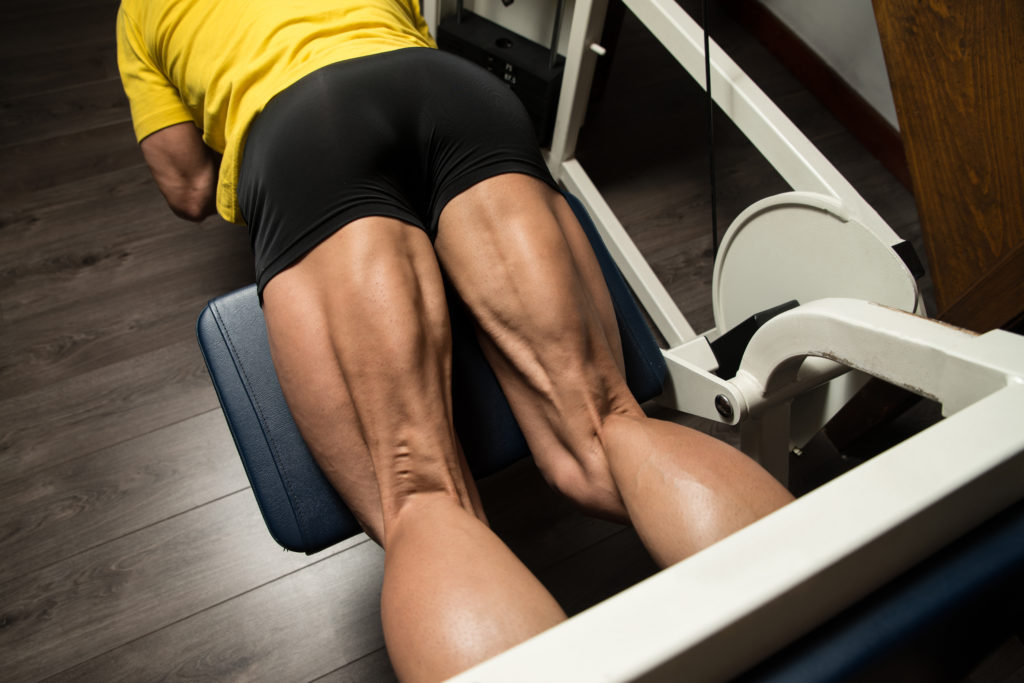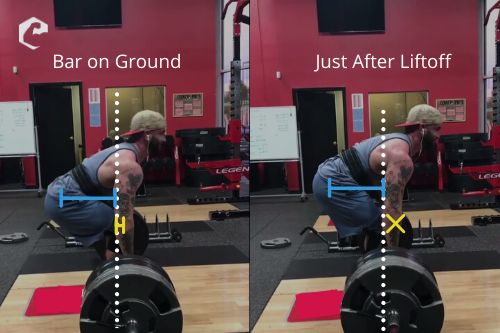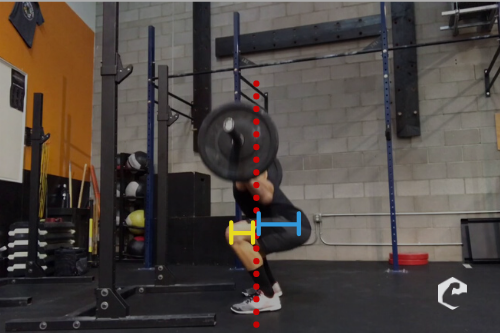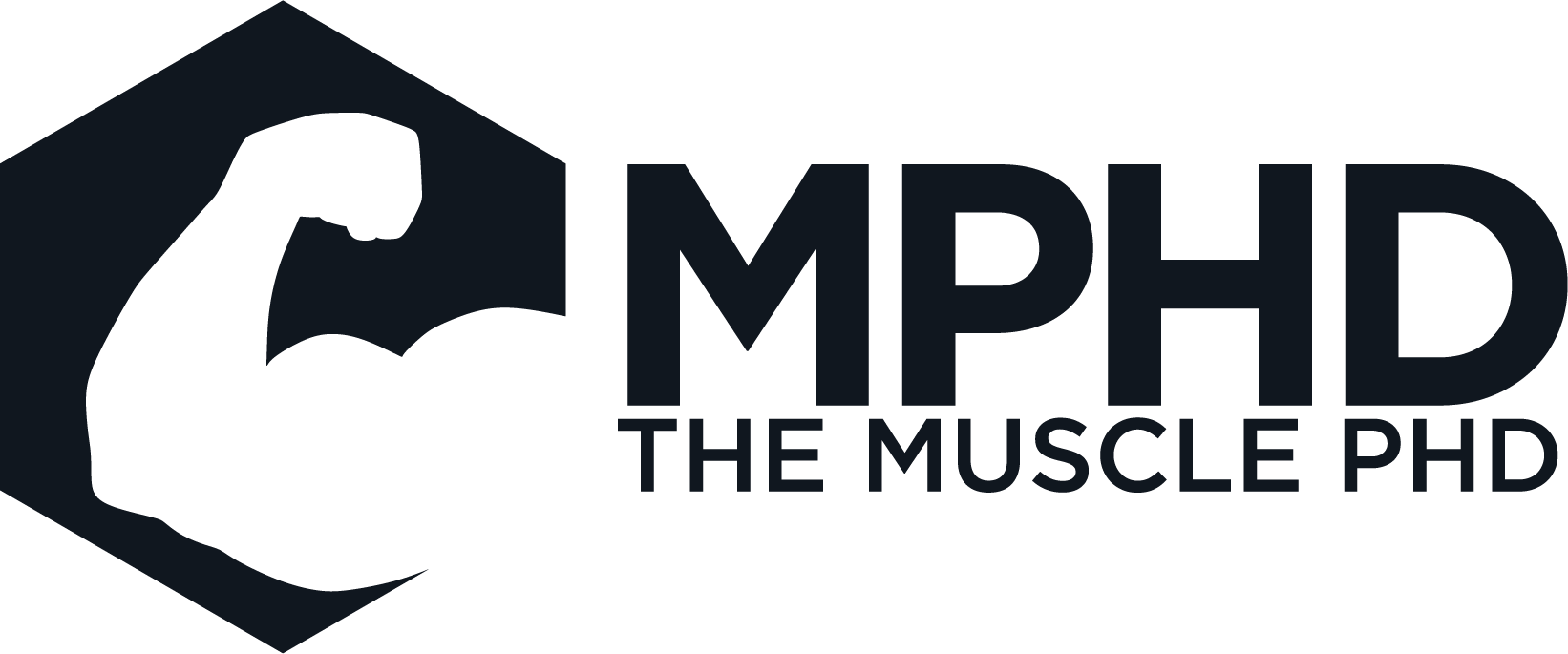Introduction
Over the past 20-years or so, we’ve seen quite a few studies report minimal hamstrings activation in the squat (2,3,5,13,14,15,17,18,19,20). However, we continue to see fitness professionals and gurus claim that squats are great for hamstrings development, and that developing the hamstrings is important for squat performance. What’s the truth here, then? Let’s get into it.
Anatomy Review
 First, we need to review the anatomy and function of the hamstrings. The hamstrings consist of three muscles: the biceps femoris (technically two muscle heads), the semitendinosus, and the semimembranosus. Every hamstrings muscle inserts onto the back of the tibia just below the knee and all of them originate on the back of the pelvis except for the short head of the biceps femoris – that originates on the middle of the femur.
First, we need to review the anatomy and function of the hamstrings. The hamstrings consist of three muscles: the biceps femoris (technically two muscle heads), the semitendinosus, and the semimembranosus. Every hamstrings muscle inserts onto the back of the tibia just below the knee and all of them originate on the back of the pelvis except for the short head of the biceps femoris – that originates on the middle of the femur.
Since the hamstrings cross two joints, they can perform actions at two joints. The hamstrings can extend the hip, like in deadlifts, back extensions, and good mornings. They can also flex the knee, like in leg curls, glute ham raises, and Nordic curls. Each hamstrings muscle can also slightly assist in things like rotation, stability, etc. but no one is training those movements in order to grow the hamstrings.
So, essentially, the hamstrings flex the knee and extend the hip. Case closed.
But wait… how does that work in a squat?
The Paradox
If we look at the muscles in the lower body, we see a ton of “zig-zagging” action where multiple muscles are crossing multiple joints. A simple glance at the anatomy of the lower body would cause one to come to a quick conclusion: it should be impossible to squat. Why can we still squat?
Much of this quandary was originally developed in 1903 by WP Lombard and was aptly coined, “Lombard’s Paradox” (10,11). The paradox essentially describes what we just discussed – how can we stand from a seated position when we have multiple muscles in the lower body performing opposing motions at different joints?
WP Lombard offered a conjecture which outlined potential rules for the intermuscular coordination of two-joint muscles (10). The hamstrings meet those terms pretty well:
- The muscle must have better leverage at the end that is an extensor – this is true for the hamstrings.
- There must also be a two joint muscle that flexes the joint the [hamstrings] extend. This is also true; the rectus femoris is a two joint muscle that flexes the hip.
- The muscle must have sufficient strength and leverage to make use of passive tendon action of the opposing muscle (rectus femoris in our example) – this is also true for the hamstrings.
When we combine these items, we find that the intermuscular coordination in the lower body creates a sort of figure-8 flow of force/energy (10). Since the hamstrings and rectus femoris both cross two joints, neither one changes length much in a squat and, thus, they can both transmit force through each other due to their opposing actions on the hip. This helps us extend our knees and hips simultaneously.
Things like running, walking, and even squatting have been a staple of human movement for millions of years. We have had time, as a species, to perfect these movements, and the squat is a great example of that. Intricate intermuscular coordination is necessary to perform a squatting motion; essentially, certain portions of each muscle have to be active at just the right time in order to squat. Unfortunately for our hamstrings development, the glutes and adductors are also prime hip extensors. So, in all reality, we don’t need our hamstrings to extend the hips in a squat.
This is why researchers continue to find minimal hamstrings activation in the squat. The hamstrings will still be slightly active in order to help stabilize the knee and transmit forces, but if they were to actually contract during a squat, we wouldn’t be able to perform the motion; our hamstrings would flex our knees and we wouldn’t be able to stand up! Lastly, this lack of activation has also been shown to lead to zero growth in long-term squat training programs (9). On the other hand, both the adductors (9) and glutes (1,9) experience significant growth from squat training.
All-in-all, the hamstrings help us perform squatting motions due to intricate intermuscular coordination patterns, but they’re not at all a prime mover. The adductors are in a much better position to extend the hips in a squat (16) as they don’t cross the knee joint. So, what does this mean for other lower body exercises that are similar to a squatting motion? Pretty much the same idea – this includes lunges, leg press, split squats, step ups, etc. etc. But we have data showing that the hamstrings are highly active in a deadlift (3) so what gives?
Squats vs. Deadlifts
Many people think that deadlifts are pretty similar to squats, but that’s really not the case at all. A stronger argument could be made for trap bar deadlifts, but we’ll keep the discussion to barbell deadlifts for now. When we compare hamstrings activity in squats and deadlifts, we have to look at the inherent biomechanics of the exercise. Both exercises involve hip extension, sure. But what joint angles are the peak hip extension forces occurring at?
 At the beginning of a deadlift, we have a very small mechanical challenge at the knee. We refer to this as a “external moment” and cover this much more in-depth in our Physics of Bodybuilding article (here). What this means is that, for a brief moment at the beginning of a deadlift, the weight is trying to flex our knees. This requires a small bit of quad activation to the get the weight moving, but once the bar is off the floor, that moment at the knee essentially disappears (7,8). Now, we’re left with a nearly pure hip extension exercise. While the hamstrings can’t extend the hips in a deep squat position, they can definitely extend the hips most of the way through a deadlift.
At the beginning of a deadlift, we have a very small mechanical challenge at the knee. We refer to this as a “external moment” and cover this much more in-depth in our Physics of Bodybuilding article (here). What this means is that, for a brief moment at the beginning of a deadlift, the weight is trying to flex our knees. This requires a small bit of quad activation to the get the weight moving, but once the bar is off the floor, that moment at the knee essentially disappears (7,8). Now, we’re left with a nearly pure hip extension exercise. While the hamstrings can’t extend the hips in a deep squat position, they can definitely extend the hips most of the way through a deadlift.
 This is one reason why stiff leg deadlifts are a better hamstrings workout than normal deadlifts – essentially, the stiff leg deadlift skips the initial quad requirement at the beginning of the lift and immediately places the hamstrings into a position to extend the hips.
This is one reason why stiff leg deadlifts are a better hamstrings workout than normal deadlifts – essentially, the stiff leg deadlift skips the initial quad requirement at the beginning of the lift and immediately places the hamstrings into a position to extend the hips.
When we compare this to a squat, we see that peak hip extension requirements are in a deep squat position where the hamstrings can’t help out much (6,8). In a well-executed squat, our knees and hips will extend at a similar rate so that the hamstrings are never really in a great position to extend the hips independently of knee flexion.
Now, what if you’re maxing on squats and end up with a little less-than-perfect form?
An Exception to the Rule?
We’ve all seen this at some point or another. Someone is maxing on a squat, whether it’s a rep max or true 1RM, and they hit the sticking point like a brick wall. We see the knees extend while the hips don’t move much and all of a sudden, this poor individual is in a good morning position at risk of getting stapled. What does this position remind us of, from a biomechanics standpoint? Looks pretty similar to a deadlift, right? In this position, hamstrings strength can absolutely be crucial for blasting through a nearly-failed squat.
So, while the squat doesn’t train or develop the hamstrings much (if at all), we can still see that hamstrings strength is incredibly important for optimizing squat performance and/or gains in general. Not every squat rep is going to be perfect, and if you’re training to maximize either strength or growth, you’re going to find yourself in that quasi-good morning position on a regular basis.
With this in mind, it’s incredibly important to add exercises like good mornings, RDL’s, and stiff leg deadlifts to help strengthen the hamstrings (and hip extensors in general) in this specific position. This is why we see many top-level powerlifters training the crap out of good mornings – these are a great “insurance” exercise for maximizing squat strength.
Conclusion
So, in a weird conclusion, both the researchers and gurus are right. The hamstrings are not very active in a squat nor are they developed much (if any) by squat training. Score, researchers. However, hamstrings strength can be a limiting factor in squat performance, especially in sets to failure or 1RM tests. Score, gurus.
Therefore, it’s important to design your training around this knowledge. If you’re a bodybuilder, make sure you’re adding plenty of hamstrings work on your leg days since your biggest exercises (squat variations) aren’t doing much for them. If you’re a powerlifter, make sure you’re adding good morning variations to train the sticking point in a squat – these are specific to this position and have a ton of carryover in max squats. As always, knowledge is power!
References
- Bloomquist, K., Langberg, H., Karlsen, S., Madsgaard, S., Boesen, M., & Raastad, T. (2013). Effect of range of motion in heavy load squatting on muscle and tendon adaptations. European Journal of Applied Physiology, 113(8), 2133-2142.
- Bourne, M. N., Williams, M. D., Opar, D. A., Al Najjar, A., Kerr, G. K., & Shield, A. J. (2017). Impact of exercise selection on hamstring muscle activation. British Journal of Sports Medicine, 51(13), 1021-1028.
- Camara, K. D., Coburn, J. W., Dunnick, D. D., Brown, L. E., Galpin, A. J., & Costa, P. B. (2016). An examination of muscle activation and power characteristics while performing the deadlift exercise with straight and hexagonal barbells. The Journal of Strength & Conditioning Research, 30(5), 1183-1188.
- Comfort, P., & Kasim, P. (2007). Optimizing squat technique. Strength and Conditioning Journal, 29(6), 10.
- Ebben, W. P. (2009). Hamstring activation during lower body resistance training exercises. International Journal of Sports Physiology and Performance, 4(1), 84-96.
- Escamilla, R. F., Fleisig, G. S., Lowry, T. M., Barrentine, S. W., & Andrews, J. R. (2001). A three-dimensional biomechanical analysis of the squat during varying stance widths. Medicine & Science in Sports & Exercise, 33(6), 984-998.
- Escamilla, R. F., Francisco, A. C., Fleising, G. S., Barrentine, S. W., Welch, C. M., Kayes, A. V., … & Andrews, J. R. (2000). A three-dimensional biomechanical analysis of sumo and conventional style deadlifts. Medicine & Science in Sports & Exercise, 32(7), 1265-1275.
- Hales, M. E., Johnson, B. F., & Johnson, J. T. (2009). Kinematic analysis of the powerlifting style squat and the conventional deadlift during competition: is there a cross-over effect between lifts? The Journal of Strength & Conditioning Research, 23(9), 2574-2580.
- Kubo, K., Ikebukuro, T., & Yata, H. (2019). Effects of squat training with different depths on lower limb muscle volumes. European Journal of Applied Physiology, 119(9), 1933-1942.
- Kuo, A. D. (2001). The action of two-joint muscles: the legacy of WP Lombard. Classics in Movement Science, 289-316.
- Lombard, W. P. (1903). The action of two-joint muscles. American Physical Education Review, 8(3), 141-145.
- Marieb, E. N., Wilhelm, P. B., & Mallatt, J. (2014). Human Anatomy (Vol. 784). Pearson.
- McCaw, S. T., & Melrose, D. R. (1999). Stance width and bar load effects on leg muscle activity during the parallel squat. Medicine and Science in Sports and Exercise, 31, 428-436.
- McCurdy, K., O’Kelley, E., Kutz, M., Langford, G., Ernest, J., & Torres, M. (2010). Comparison of lower extremity EMG between the 2-leg squat and modified single-leg squat in female athletes. Journal of Sport Rehabilitation, 19(1), 57-70.
- Ono, T., Higashihara, A., & Fukubayashi, T. (2011). Hamstring functions during hip-extension exercise assessed with electromyography and magnetic resonance imaging. Research in Sports Medicine (Print), 19(1), 42.
- Németh, G. (1984). On hip and lumbar biomechanics. A study of joint load and muscular activity. Scandinavian Journal of Rehabilitation Medicine. Supplement, 10, 1-35.
- Palmieri-Smith, R. M., McLean, S. G., Ashton-Miller, J. A., & Wojtys, E. M. (2009). Association of quadriceps and hamstrings cocontraction patterns with knee joint loading. Journal of Athletic Training, 44(3), 256-263.
- Paoli, A., Marcolin, G., & Petrone, N. (2009). The effect of stance width on the electromyographical activity of eight superficial thigh muscles during back squat with different bar loads. The Journal of Strength & Conditioning Research, 23(1), 246-250.
- Schaub, P. A., & Worrell, T. W. (1995). EMG activity of six muscles and VMO: VL ratio determination during a maximal squat exercise. Journal of Sport Rehabilitation, 4(3), 195-202.
- Yamashita, N. (1988). EMG activities in mono-and bi-articular thigh muscles in combined hip and knee extension. European Journal of Applied Physiology and Occupational Physiology, 58(3), 274-277.
From being a mediocre athlete, to professional powerlifter and strength coach, and now to researcher and writer, Charlie combines education and experience in the effort to help Bridge the Gap Between Science and Application. Charlie performs double duty by being the Content Manager for The Muscle PhD as well as the Director of Human Performance at the Applied Science and Performance Institute in Tampa, FL. To appease the nerds, Charlie is a PhD candidate in Human Performance with a master’s degree in Kinesiology and a bachelor’s degree in Exercise Science. For more alphabet soup, Charlie is also a Certified Strength and Conditioning Specialist (CSCS), an ACSM-certified Exercise Physiologist (ACSM-EP), and a USA Weightlifting-certified performance coach (USAW).




